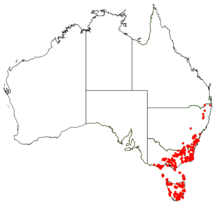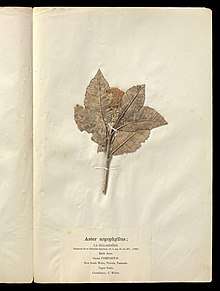Olearia argophylla
Olearia argophylla is a species of flowering plant in the family Asteraceae. Its common names are musk daisybush, musktree, muskwood and silvershrub. It is found in Australia, specifically in New South Wales, Tasmania and Victoria.[1] It grows as a tall shrub or tree characteristic of wet sclerophyll forest. Its leaves are large and broad (6–15 cm x 2–5 cm), coarsely toothed, green on top and silver-white underneath.[2] The grain of the wood is mainly straight, but burls near the base of the tree are prized for their brown swirls that often suggest the appearance of small faces or animals peering out of the wood, making them highly sought after by woodworkers.[3]
| Olearia argophylla | |
|---|---|
_(24631211899).jpg) | |
| O. argophylla foliage and flowers | |
| Scientific classification | |
| Kingdom: | |
| Phylum: | |
| Class: | |
| Subclass: | |
| Superorder: | |
| Order: | |
| Family: | |
| Genus: | |
| Species: | O. argophylla |
| Binomial name | |
| Olearia argophylla (Labill.) F. Muell. ex Benth. | |
 | |
Description
Olearia argopylla is an open to dense, medium to tall shrub or small tree (3-15m x 2-6m).[4][5][6] Its bark is grey, fissured to ribbony, flaky and its branchlets covered in dense silvery hairs.[6][7] It has large, alternate, ovate to broadly elliptic,[7] shiny dark-green leaves with a silvery underside 6–15 cm long x 2–7 cm wide, often (but not always) with slightly serrated margins[6][5] and roughly 25mm petiole.[7] It has many pseudanthium 12-27mm in diameter, with 3-8 white ray florets and 3-8 yellow disc florets[7] arranged in large terminal bunches.[5][6] Flowers mainly between September–April.[5][7][8]
Taxonomy

The first occurrence of Olearia argophylla was published in Flora Australiensis vol. 3.[10] There are records, however, of earlier discovery of the plant under the synonym Eurybia argophylla in the French Dictionnaire des Sciences Naturelles Edn. 2, 37: 487 which dates back to 1825,[11][12][13] and even earlier in Novae Hollandiae Plantarum Specimen 2(20-21) under the synonym Aster argophyllus (1806).[11][14][15][16][17]
Distribution and habitat
Olearia argophylla grows commonly on cool moist sheltered slopes and in fern gullies, mostly in taller Eucalypt forests,[18][19] and is found widespread across Victoria (Australia), Tasmania and Eastern New South Wales.[20][21][10][6]
Cultivation
Olearia argophylla can be propagated from Seed, or sometimes from cuttings.[20][22] It may be suitable as a screen or windbreak plant under established trees.[6][23] Prefers moist well drained soils[5][19] that are neutral or slightly acidic.[20][24] It prefers partial to full shade[5][19][20] and is frost tolerant.[5][20][24]
References
- "Olearia argophylla". Germplasm Resources Information Network (GRIN). Agricultural Research Service (ARS), United States Department of Agriculture (USDA). Retrieved 21 January 2018.
- Species reference, University of Tasmania. http://www.utas.edu.au/docs/plant_science/field_botany/species/dicots/astersp/oleaargo.html (accessed 11 September 2010).
- Yanni Rigos Wood Alchemy (with image) http://www.woodalchemy.com/woods/musk (accessed 11 September 2010).
- Howells, Christine (2012). Tasmania's Natural Flora. Hobart: Australian Plants Society Tasmania Inc., Hobart Group. p. 54. ISBN 9780909830663.
- ".: Olearia argophylla :". fe.yarraranges.vic.gov.au. Retrieved 19 March 2020.
- "Flora of Victoria". vicflora.rbg.vic.gov.au. Retrieved 19 March 2020.
- "Olearia argophylla". keys.lucidcentral.org. Retrieved 19 March 2020.
- "Factsheet - Olearia argophylla". floragreatlakes.info. Retrieved 19 March 2020.
- Australia, National Museum of (1 January 1875). "Aster Argophyllus". National Museum of Australia. Retrieved 19 March 2020.
- Australia, Atlas of Living. "Olearia argophylla : Muskwood". bie.ala.org.au. Retrieved 19 March 2020.
- "Eurybia argophylla (Labill.) Cass. — The Plant List". www.theplantlist.org. Retrieved 19 March 2020.
- "Vascular Plants". biodiversity.org.au. Retrieved 19 March 2020.
- "Eurybia argophylla (Labill.) Cass. | Plants of the World Online | Kew Science". Plants of the World Online. Retrieved 19 March 2020.
- Labillardière, Jacques Julien Houton de. Novæ Hollandiæ plantarum specimen /. v.2. Parisiis :: Ex typographia Dominæ Huzard,.CS1 maint: extra punctuation (link)
- "Vascular Plants". biodiversity.org.au. Retrieved 19 March 2020.
- "Aster argophyllus Labill. — The Plant List". www.theplantlist.org. Retrieved 19 March 2020.
- "Aster argophyllus Labill. | Plants of the World Online | Kew Science". Plants of the World Online. Retrieved 19 March 2020.
- Costermans, L. F., author. Native trees and shrubs of south-eastern Australia. OCLC 1136496064.CS1 maint: multiple names: authors list (link)
- "Search". www.understorey-network.org.au. Retrieved 19 March 2020.
- "Olearia argophylla – Musk Daisy Bush | Gardening With Angus". www.gardeningwithangus.com.au. Retrieved 19 March 2020.
- "Search: SPECIES: Olearia argophylla | Occurrence records | Atlas of Living Australia". biocache.ala.org.au. Retrieved 19 March 2020.
- "Olearia argophylla". www.treeproject.org.au. Retrieved 19 March 2020.
- "Plants of Tasmania Nursery & Gardens". www.potn.com.au. Retrieved 19 March 2020.
- "Olearia argophylla | Musk Daisy Bush information & photos". www.plantthis.com.au. Retrieved 19 March 2020.
| Wikimedia Commons has media related to Olearia argophylla. |